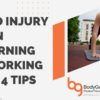With NASA adding its first physical therapist to treat the astronaut corps, it’s time to consider the benefits of PT much closer to home.
In September, NASA made “one giant leap” for the health and safety of its astronaut corps, adding a full-time physical therapist position to its Astronaut Strength, Conditioning and Rehabilitation team.
From the G-forces on atmospheric takeoff and reentry to the zero-gravity conditions that have been known to atrophy muscles, lead to bone loss and temporarily elongate the spine, musculoskeletal problems are baked into the job of being an astronaut. Even with two hours of exercise each day on long space missions, the difference in muscle mass and performance before and after a space flight can be similar to the age-related losses between a 20-year-old vs. an 80-year-old.
Assisting before, during and after the mission, the astronaut support team has always included athletic trainers and certified strength and conditioning specialists. The addition of a physical therapist is a first.
Air Force Maj. Danielle Anderson has been named to the position and will work to ensure that any physical therapy insights are shared with the Air Force, Space Force, and PT community at large.
“We’re constantly learning new ways to optimize human performance both in space flight as well as post-flight conditioning,” Anderson told the Rocky Mountain Collegian. “Every day here is different. I support care across the continuum of prevention of injury to rehab of injury and then to returning back to flight status as our astronauts return home.”
While the environment may be different, her role is much the same as any other physical therapist: find functional solutions to help patients feel and move better.
“As a physical therapist, if an injury comes up on board and they need advice on changing their exercise routine or potentially needing to rehab something,” she added, “I work with the flight surgeon and their strength coach to design programs by sending videos and video chatting to rehab them from space if they need it.”
This is not the first time insights from a galaxy far, far away have profoundly impacted the physical therapy profession. Here are several examples of how space travel has improved PT on Earth.
1. Bowflex Technology
Lifting weights is a great way to build strength on Earth but does little to help astronauts in a zero or microgravity environment. In the early 1990s, American inventor Paul Francis envisioned a weightlifting system that didn’t use weights, and leveraged NASA and Lockheed Martin to develop Spiraflex.
At NASA, the technology was called Interim Resistance Exercise Device, and it lived on the International Space Station between 2000 and 2010. Astronaut Leroy Chiao even credited the IRED with scoring higher on his post-flight strength tests than he had before leaving.
Most consumers will know the technology better as Bowflex, produced by Nautilus and launched to the public in 2005.
Like resistance bands, which are very common in the PT profession, Spiraflex technology makes efficient use of space and weight. An improvement over traditional elastic: instead of the resistance progressively increasing, FlexPack technology helps keep resistance linear throughout the full range of motion.
2. AlterG Treadmill
One way NASA creates resistance in an anti-gravity environment is by using air pressure in a chamber around a treadmill. Runners are suspended half in the chamber, where pressure can be added to simulate Earth’s gravity and provide a more effective cardio workout for astronauts.
That technology, developed by Ames Research Center scientist Robert Whalen, was first called a G-Trainer for astronauts and was deployed in the early 1990s.
Whalen’s commercial product, the AlterG, can also be reversed on Earth, using air pressure to reduce treadmill resistance by as much as 80%. The treadmill’s successes include:
- keeping astronauts physically fit
- helping pro athletes like Blake Griffin, Charlie Davies and Jim Leonhard return from injury
- assisting wounded veterans in rehabbing injuries or adjusting to prosthetics
- protecting seniors from impact injuries while providing a safe form of cardio exercise.
3. Shuttle 2000-1
Skylab was the only space station ever operated exclusively by the United States. Launched in 1973 and operational for only 24 weeks, this station included the state-of-the-art CMC Shuttle 2000-1, developed by Boeing engineer Gary Graham.
To use the equipment, astronauts lie back on a carriage that glides on a rail, powered by pushing their feet on a kick plate and pulling themselves with elastic cords. The exercise, known as plyometrics, provides fast muscle contractions that strengthen muscles, bones and the heart.
Refined into the commercially available Shuttle 2000-1 in 1991, the technology is frequently used for patients on bed rest.
Ready for What Comes Next
From exercise equipment to Memory Foam, insulin pumps to water filters, we owe a lot to extraterrestrial innovation. With a permanent physical therapist on staff at NASA, there’s no telling what the next generation of PT innovation will hold.
What we do know is this: the team at Body Gears will continue pushing the limits of PT care, adopting the latest technology and techniques to improve your health and well-being. With your health benefits about to turn over for the new year, now is the perfect time to visit one of our six Chicagoland centers for a free 20-minute screening. Meet our care team and let’s improve your outlook to infinity and beyond.






